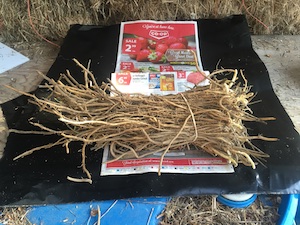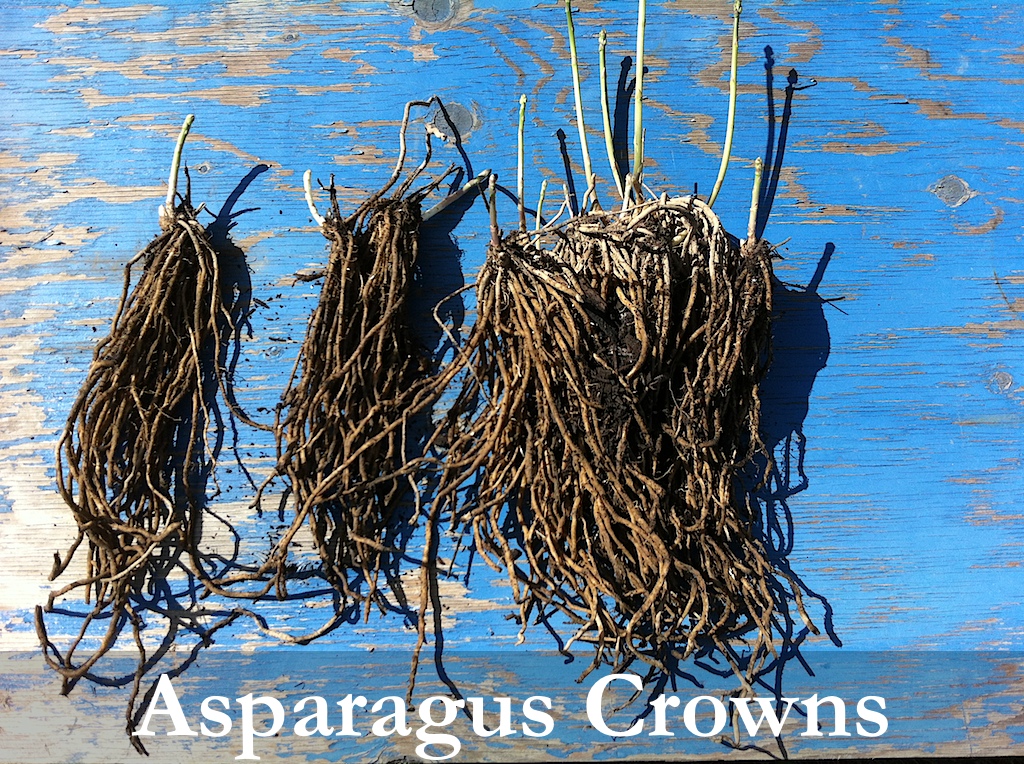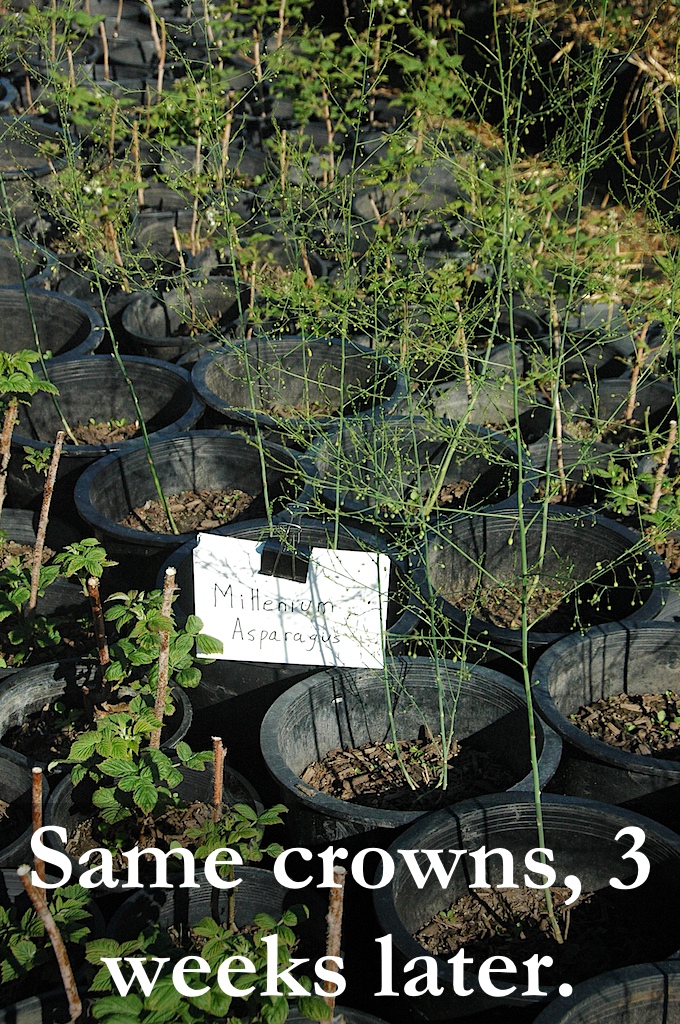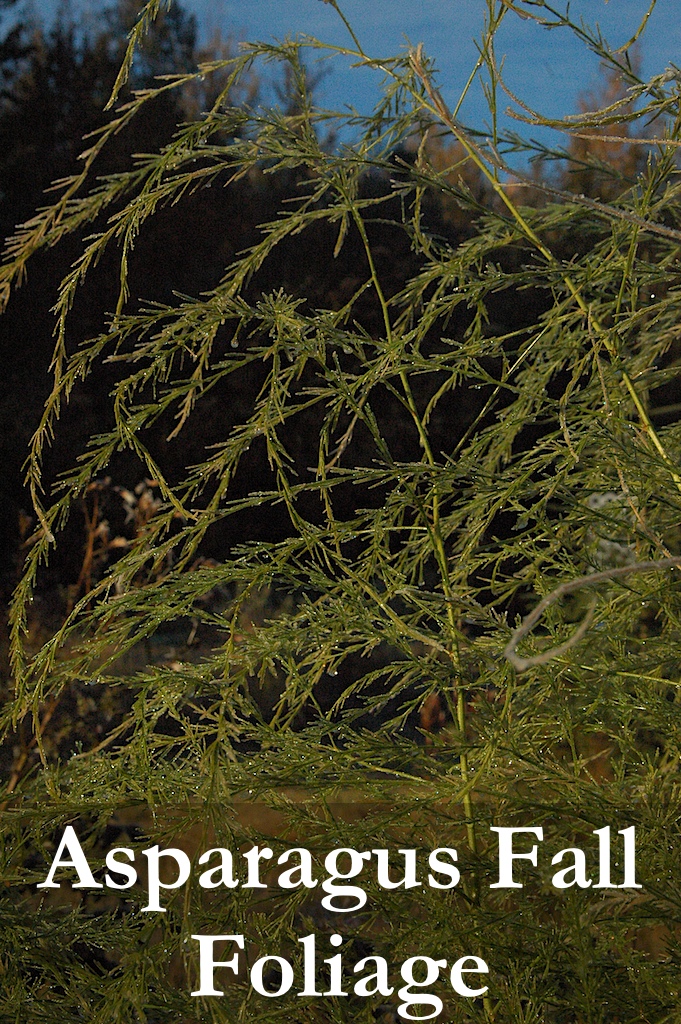Perennial Vegetables
Plant once, harvest for years
Trees and shrubs have woody bits that continue to grow. Here we have a few things for edible landscaping that are probably going to be tucked into the edges of the veggie garden.

This is a bundle being packed for shipping. I roll them in damp newspaper to keep them humid on their way to their new home.

This a bundle, opened up, showing the individual plants. Each plant looks like a string mop with a knot where the strings join. These are 2 year old crowns. Individual plants are 6-8 inches long.

Each crown sends up 2-5 spears. Don't harvest the first year.

Same asparagus -- Mid summer. Let them grow, to build the root stronger. Next summer you can pick for 1 week. The summer after that for 2. Eventually 7 weeks.
Asparagus
Do NOT plant asparagus on a whim. There is significant prep to be done. Asparagus requires rich loamy to sandy, well drained soil, with a fair amount of nitrogen.
Asparagus is a long term commitment. It's awkward to deal with in the garden as it slowly spreads. Tilling close to it can result is small plants everywhere. Many people plant it in it's own bed, surrounded by a weed barrier or lawn.
Each plant needs about a foot and a half of room. So a bundle of 20 ideally has a 30 foot bed. You can crowd this a bit, but it means your bed life is shortened.
Dig a trench 16 inches deep. Partially fill with rich loam. make a 4" high ridge in the middle. Top of the ridge should be 8" below the top of the trench. Put plants every 12-18" with roots spread out over the ridge, and just cover. Keep moist. After they sprout, graduallly add soil/compost/manure until about 2" below the top of the trench.
Putting down a walkway of used carpet fuzzy side down on either side makes weed control much easier. Roll up the carpet in winter, lay it back down in spring when weeds start showing. If the carpet is stored dry for winter it will last 2-3 times as long. Moving it breaks the roots of wannabee weeds that are working through it.
Fall maintenance
In fall top up the trench with compost. Repeat this every year. Top with a foot of leaves from your lawn to increase frost protection. (The bagged cow manure you get at the garden stores works well. Watch for sales in fall)
The leaves will slow down the ground cooling, giving the roots more time to adjust. They will protect the roots if we have one of those falls where it stays nice into November then drops to -30 with no snow cover.
Raised Beds
If you have heavy clay soils, use a raised bed instead. The roots will rot in heavy wet soils. A trench in clay soil tends to fill, unless on a slope.
Raised beds are great. Make them at least 3 feet wide. I suggest making them 12 to 16 inches high. (Three 2x6’s is 16.5 inches) You will be harvesting asparagus for 30 years. You will be going out there 3 times a week for 8 weeks. You still have to weed it. Having the bed at a knee height makes it all a bunch easier.
Put the base of your bed on a double layer of thick (6 mil) black plastic. The water will find it's way out through the edge. Keep grass a few inches away from the base of the bed. Tiger torch works great for this. If quack grass gets into the bed, you will have a tough time getting rid of it. Worst case: Put on a cotton glove over a latex glove and lovingly stroke each strand of grass with a fingertip soaked in roundup.
The boards will rot in about 8 years, bottom row especially. You want the boards to be fastened to the outside of the stakes. Often, however the dirt will have settled enough that you can remove the board and replace it. Use pressure treated fence posts for the support though, and use lag bolts to fasten the boards. They can be undone in 8 years. You might be able to get more time by painting the edges and the inside faces of the boards. Let the outside be, so water that gets into the wood can get out. Drill the holes for the bolts, paint the inside of the hole. (q-tip, pipecleaner) Use one board as a template and take care drilling the holes, so that the board can go on in any of it's 4 possible orientations. If you make the holes oversize, (7/16" for 1/4" lag bolts) and use a big washer on the lag bolt, then the inside of the hole dries out and doesn't rot. YOur chance of not needing a new hole in the post are improved.
On the third board change use screws 1 inch longer.
If you are concerned about the chemicals in PT wood leaching, wrap the posts with the same plastic you use for the base.
A raised bed dries out faster. Good thing if you have clay. But it does mean you need to water more often. I suggest that you put soaker hoses in place permanently, and hook your garden hose to them whenever the top of the soil under the mulch gets dry. Typically once every week or two. Maybe more often in August.
Picking
Do not pick this year.
Next year cut for one week. Cutting is a misnomer. You actually get down to the base of the spear and bend it so that it snaps. Check for new spears every other day. Spears can be stored in the fridge standing upright in water for a week, longer if they are going to be made into soup. This level of stooping is another reason to put in a raised bed.
It takes about 6 years to get to full production. Add a week of picking each year. You can extend it some by not picking all of them. Spears keep a week in the fridge stadning upright in water.
A mature plant, (7 yr old) will give you about 1/2 pound of asparagus a year. 20 crowns is sufficient for a few feeds a summer. If you are wild about asparagus, plant more.
While they are getting bigger, you can use the space around them for growing fast salad crops -- radishes, lettuce, chard, and annual herbs like basil, savory, oregano. They also tell you right away if the bed needs watering.
The root clump gets about 18" wide. On a raised bed You need the extra foot on each side for winter protection. You should be able to grow an edge of annual veg every year in the bed. Just at the start, you have 2 rows.
Notes
Watch for female plants, they will have berries in the fall. The put more energy into berries, and less into roots. Grub the females out. There are hybrids that have the occasional berry. Keep them, they are very productive. Millenium is one.
We carry Millenium, a cultivar developed at the U. of Guelph in Ontario. It's better suited to our cold climate. Still, it's nominally a zone 4 plant. Try to arrange for extra winter protection. Do not cut the fronds in fall -- they will help collect snow to insulate the ground.
Be on watch for pocket gophers (vegan moles...) They will eat your entire row if they get into it. You will see mounds of dirt with no obvious hole.
Asparagus info at Farmer's Almanac More asparagus info. In addition to more tips on growing, this site has abundant recipes, how-tos on freezing, canning, grilling... Growing asparagus
Information on growing in commercial production on a hobby farm. [Small Scale Commercial Asparagus production][https://www.hobbyfarms.com/crop-profile-asparagus-3/]
Inventory tables are double rows to make them usable on small screens.
Common name and container in column 1.
Count is how many we think we have left. Price is per tree.
Height will be there next year, we hope.
Food -- Asparagus
| Common Name Container |
Count Price |
Height (feet) |
|
| Asparagus, Millennium Crown |
915 $2.25 |
||
| Last Update: 2024-Jan-21 | |||

Rhubarb
Rhubarb is one of those simple plants that keeps on giving. For most of us, one plant is enough for the occasional pie, a batch of jam or sauce. But there are cookies, fruit bars, chutneys, wine !, soups.
Note: The leaves are poisonous. They contain oxalic acid, one of the same ingrediants used in radiator cleaner. Should be possible to make a stain remover from the leaves.
I stock Canada Red, a very cold hardy plant with moderate sized stalks. Usually we get a few crowns in each spring, plus I have a few in large pots for the impatient. It should be a good deck plant. Place on ground and surround with bags of leaves in the winter.
More than you ever wanted to know about growing Rhubarb along with a zillion recipes for using it.
Inventory tables are double rows to make them usable on small screens.
Common name and container in column 1.
Count is how many we think we have left. Price is per tree.
Height will be there next year, we hope.
Food -- Rhubarb
| Common Name Container |
Count Price |
Height (feet) |
|
| Rhubarb, Canada Red Crown |
13 $12.50 |
||
| Last Update: 2024-Jan-21 | |||
Sunchokes
Helianthus tuberosus
These are also known as Jerusalem artichokes. They are actually a member of the sunflower family. The roots have a carbohydrate called inulin instead of starch. Inulin converts to sugar much more slowly than starch, and so is better for diabetics.
The plants can be invasive, spreading beyond where they are welcome. Another good reason for doing them in pots.
Try to plant them on the south side of a wall. They need an early spring and long season to get decent yields.
Avoid wet soil. Tubers will rot. Remove flowers to encourage the plant to make tubers.
Cooking
The internet is your friend here. Raw they are much like water chestnuts, and can be used in stir fries that way. They roast well, but cook faster than potatoes or yams. They don't go 'creamy' at all, so if mashing them, you will want to mix with potatoes or yams. Once source says they pickle well.
Go easy on them at first. For some people inulin produces large quantities of gas.
Harvesting and Storage
Harvesting is done like potatoes, dig them up in the fall. Leave the smaller ones in the ground to grow next year's crops. They do not keep like potatoes however. They need to be refrigerated. You can however leave them in the garden and dig up as needed. This is tough in our climate. I'm thinking about trying to grow them in strawbales. Seems to me they would be easier to harvest mid winter. Or grow in 5 gallon pails, bring one in to thaw, then take back outside to dump and go through the dirt for the chokes.
Do not remove dirt before storing. Like potatoes they keep longer. One thing I've not found out: Should they be dried a bit to get a tougher skin, as spuds are?
They will keep 2 to 5 months in cold moist conditions. If you have a cold root cellar (near freezing) try layering them in damp sand or peatmoss. (This may be an alternate storage technique: Pack in pails of cold damp peat, and store on the north side of the barn with a lid. Dig out a pail and bring in as needed.
I have a small number of growing plants in large pots.
Before you plant Sunchokes Article about the invasiveness of these guys. After reading this one: Give them their own garden, Mow around it.
Storage -- on Homesteading Today Good forum thread about storage.
Growing Sunchokes: Purdue University
Got something to say? Email me: sfinfo@sherwoods-forests.com
Interesting? Share this page.
Want to talk right now? Call me: (8 am to 8 pm only, please) 1-780-848-2548
Do not arrive unannounced. Phone for an appointment. Why? See Contact & Hours That same page gives our hours of operation.
Back to Top
Copyright © 2008 - 2021 S. G. Botsford
Sherwood's Forests is located about 75 km southwest of Edmonton, Alberta. Please refer to the map on our Contact page for directions.
